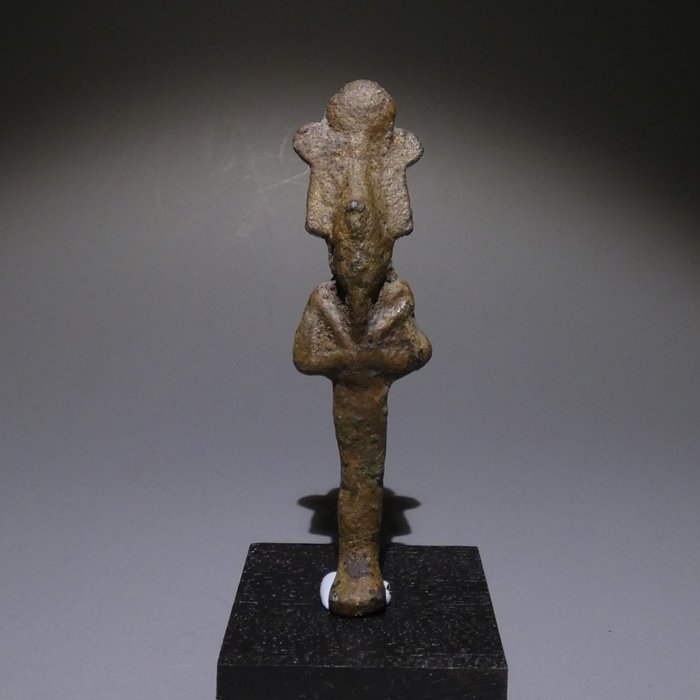
Oud-Egyptisch Brons OsirisGod. Late periode, 664 - 332 v.Chr. 15cm H.
Nr. 82386185

Nr. 82386185

God Osiris figure
Ancient Egypt, Late Period, 664 - 332 BC
MATERIAL: Solid bronze
SIZE: Height 8,3 cm
PROVENANCE: Private collection, London, 1970s.
CONDITION: Good, see photos.
Osiris, one of the most important gods of ancient Egypt. The origin of Osiris is obscure; he was a local god of Busiris, in Lower Egypt, and may have been a personification of chthonic (underworld) fertility. By about 2400 BCE, however, Osiris clearly played a double role: he was both a god of fertility and the embodiment of the dead and resurrected king. This dual role was in turn combined with the Egyptian concept of divine kingship: the king at death became Osiris, god of the underworld; and the dead king’s son, the living king, was identified with Horus, a god of the sky. Osiris and Horus were thus father and son. The goddess Isis was the mother of the king and was thus the mother of Horus and consort of Osiris. The god Seth was considered the murderer of Osiris and adversary of Horus.
According to the form of the myth reported by the Greek author Plutarch, Osiris was slain or drowned by Seth, who tore the corpse into 14 pieces and flung them over Egypt. Eventually, Isis and her sister Nephthys found and buried all the pieces, except the phallus, thereby giving new life to Osiris, who thenceforth remained in the underworld as ruler and judge. His son Horus successfully fought against Seth, avenging Osiris and becoming the new king of Egypt.
Osiris was not only ruler of the dead but also the power that granted all life from the underworld, from sprouting vegetation to the annual flood of the Nile River. From about 2000 BCE onward it was believed that every man, not just the deceased kings, became associated with Osiris at death. This identification with Osiris, however, did not imply resurrection, for even Osiris did not rise from the dead. Instead, it signified the renewal of life both in the next world and through one’s descendants on Earth. In this universalized form Osiris’s cult spread throughout Egypt, often joining with the cults of local fertility and underworld deities.
The idea that rebirth in the next life could be gained by following Osiris was maintained through certain cult forms. In the Middle Kingdom (1938–c. 1630 BCE) the god’s festivals consisted of processions and nocturnal rites and were celebrated at the temple of Abydos, where Osiris had assimilated the very ancient god of the dead, Khenty-Imentiu. This name, meaning “Foremost of the Westerners,” was adopted by Osiris as an epithet. Because the festivals took place in the open, public participation was permitted, and by the early 2nd millennium BCE it had become fashionable to be buried along the processional road at Abydos or to erect a cenotaph there as a representative of the dead.
Osiris festivals symbolically reenacting the god’s fate were celebrated annually in various towns throughout Egypt. A central feature of the festivals during the late period was the construction of the “Osiris garden,” a mold in the shape of Osiris, filled with soil. The mold was moistened with the water of the Nile and sown with grain. Later, the sprouting grain symbolized the vital strength of Osiris.
At Memphis the holy bull, Apis, was linked with Osiris, becoming Osiris-Apis, which eventually became the name of the Hellenistic god Serapis. Greco-Roman authors connected Osiris with the god Dionysus. Osiris was also identified with Soker, an ancient Memphite god of the dead.
Zo koop je op Catawiki
1. Ontdek iets bijzonders
2. Plaats het hoogste bod
3. Veilig betalen